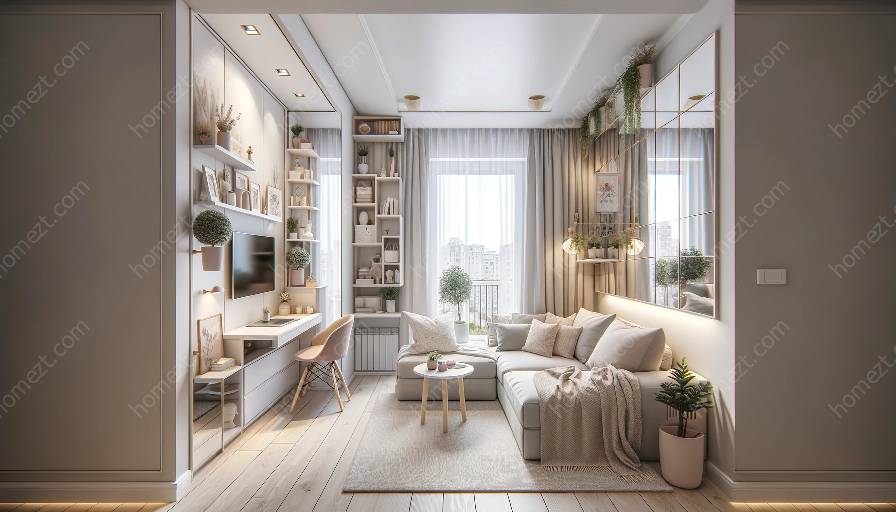Small rooms can often pose a challenge when it comes to creating a sense of space and openness. However, with the right lighting strategies, it is possible to make small rooms feel larger, more inviting, and well-decorated. This article will explore various lighting techniques to enhance small spaces, complement the overall decorating theme, and create an illusion of spaciousness.
Understanding Small Spaces
Before delving into lighting tips, it's important to understand the concept of small spaces. Small rooms can feel cramped and confined, often lacking natural light and adequate airflow. This can create a sense of claustrophobia and hinder the room's functionality. However, with the right approach, small spaces can be transformed into cozy, inviting areas that not only serve their purpose but also exude charm and style.
The Role of Lighting
Lighting plays a crucial role in creating an illusion of space in small rooms. By strategically incorporating various lighting elements, it is possible to maximize the perceived size of the room and elevate its overall aesthetic appeal. Here are some key lighting strategies to consider:
Natural Light
Maximizing natural light is essential in small rooms. Consider using light, sheer curtains or blinds to allow ample sunlight to enter the room. Additionally, strategically placed mirrors can help reflect natural light, making the room appear larger and more open. Furthermore, keeping windows unobstructed and clean will amplify the effect of natural light, creating a sense of spaciousness.
Layered Lighting
Layered lighting involves the use of multiple light sources to create depth and dimension in the room. In small spaces, it's beneficial to incorporate ambient, task, and accent lighting to ensure adequate illumination while adding visual interest. Ambient lighting, such as overhead fixtures or recessed lights, provides overall illumination. Task lighting, such as desk lamps or under-cabinet lights, serves specific functions and contributes to a sense of functionality. Lastly, accent lighting, like wall sconces or decorative lamps, highlights architectural features and adds personality to the room.
Color Temperature
The temperature of light can significantly impact the perception of space. Cooler light temperatures, such as daylight or cool white, can create a sense of freshness and openness, making small rooms feel more spacious. On the other hand, warmer light temperatures can evoke a cozy, intimate feel, which can be beneficial in certain areas of the room, such as seating areas or reading corners.
Space-Saving Fixtures
When dealing with small rooms, it's imperative to choose lighting fixtures that are proportionate to the space. Opt for sleek, compact fixtures that provide adequate illumination without overwhelming the room. Wall-mounted sconces, pendant lights, and recessed lighting are excellent choices for small rooms as they conserve floor and surface space while contributing to the overall aesthetics.
Complementing Small Spaces
Aside from creating a sense of space, lighting also plays a crucial role in complementing small spaces and enhancing their overall appeal. Here are some ways to utilize lighting to complement small rooms:
Highlighting Key Elements
Strategic lighting can be used to accentuate key elements of the room, such as artwork, architectural details, or focal points. Consider installing adjustable track lighting or picture lights to draw attention to these features, adding depth and visual interest to the space.
Creating Focal Points
Well-placed lighting can help create focal points within the room, drawing the eye to specific areas and diverting attention from the room's size. Whether it's a statement pendant light above a dining table or a well-lit shelving unit, creating focal points can add character and style to small rooms.
Enhancing Decorative Elements
Lighting fixtures themselves can serve as decorative elements in small rooms. Choose fixtures that complement the overall decor and style of the room, whether it's a modern chandelier, a vintage-inspired pendant light, or minimalist wall sconces. The right lighting fixtures can contribute to the room's ambience and visual appeal.
Conclusion
With thoughtful planning and strategic implementation, lighting can be a powerful tool in creating a sense of space in small rooms. By optimizing natural light, leveraging layered lighting, considering color temperature, and choosing space-saving fixtures, small rooms can be transformed into inviting, well-decorated spaces that feel open and welcoming. Understanding how to utilize lighting to complement small spaces and enhance their overall appeal will ensure that every corner of the room is utilized to its fullest potential.






































